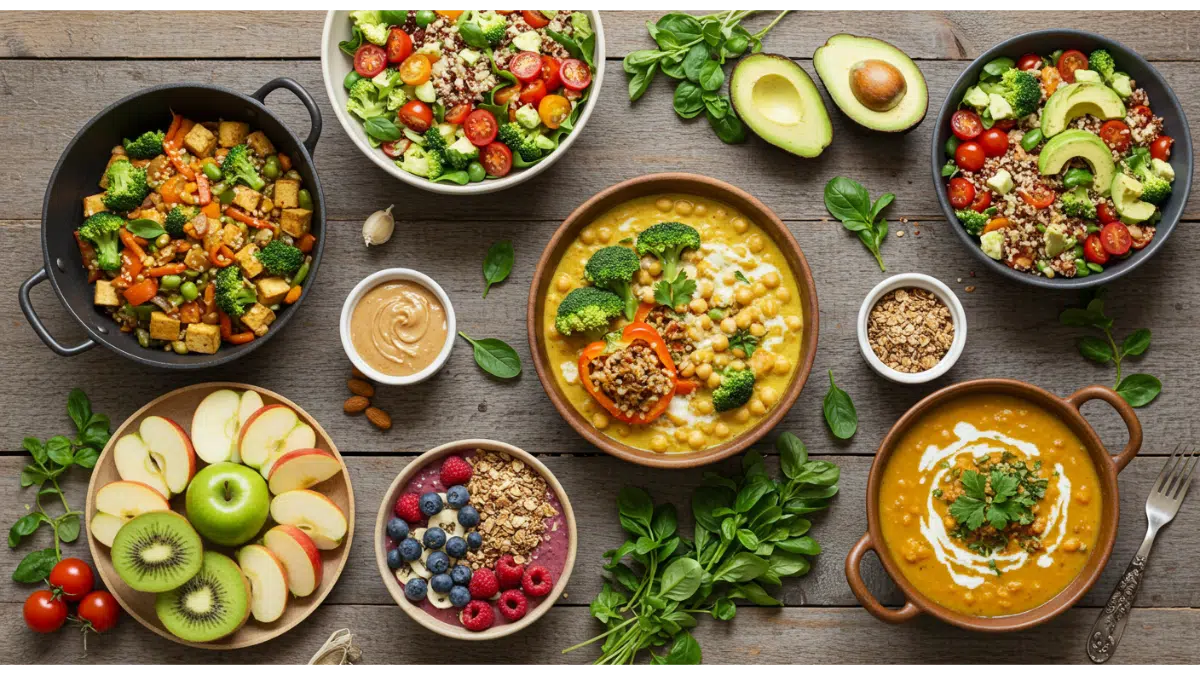A Powerful 7-Day Vegetarian Meal Plan You Must Try!
Embarking on a vegetarian journey can be a transformative experience for both your health and the environment. With the rising awareness of the benefits of plant-based diets, many individuals are exploring vegetarianism not just as a dietary choice but as a lifestyle change. This comprehensive 7-day vegetarian meal plan is designed to simplify your transition into plant-based eating while ensuring you receive all the essential nutrients. Whether you’re a seasoned vegetarian or a curious beginner, this guide provides delicious recipes, practical tips, and nutritional insights to help you thrive.
In today’s busy environment, it can often feel daunting to keep a well-balanced diet. However, planning your meals ahead of time can lead to better food choices and a healthier lifestyle. This meal plan not only emphasizes the importance of incorporating a variety of fruits, vegetables, whole grains, and legumes but also highlights the joy of cooking and savoring wholesome meals.
Key Aspects of a 7-Day Vegetarian Meal Plan
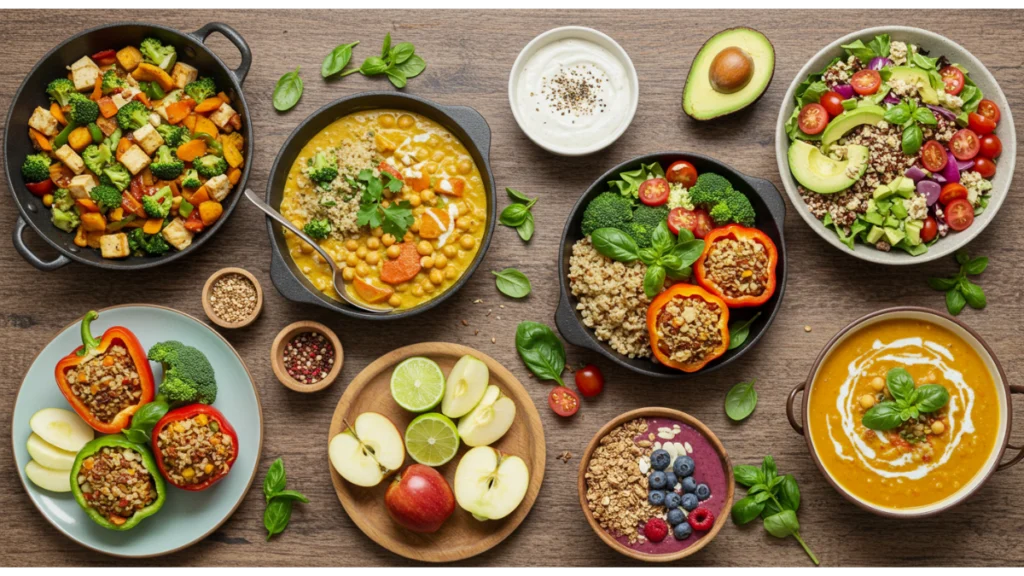
A well-structured vegetarian meal plan offers numerous benefits, including improved heart health, weight management, and enhanced energy levels. Studies show that individuals who follow a vegetarian diet tend to consume more fruits, vegetables, and whole grains, leading to a lower risk of chronic diseases.
- Nutritional Benefits
- Heart Health: Vegetarian diets are typically lower in saturated fats and cholesterol, which can lead to improved heart health. Incorporating more plant-based foods can help lower blood pressure and cholesterol levels.
- Weight Management: Many people find that a vegetarian diet helps them maintain a healthy weight. The high fiber content in fruits, vegetables, and whole grains can promote satiety, reducing overall calorie intake.
- Digestive Health: The increased intake of dietary fiber from plant-based foods supports healthy digestion and regularity.
- Environmental Impact
- Choosing a vegetarian diet can significantly reduce your carbon footprint. The production of plant-based foods generally requires less energy, land, and water compared to animal products, contributing to a more sustainable food system.
- Culinary Exploration
- A vegetarian meal plan encourages culinary creativity. You’ll have the opportunity to explore new ingredients, flavors, and cooking techniques, making your meals more exciting and enjoyable.
Ingredients You’ll Need for the 7-Day Vegetarian Meal Plan
To kickstart your week of healthy eating, gather the following ingredients:
- Fresh Fruits: Bananas, berries, apples, oranges, and seasonal fruits.
- Vegetables: Spinach, kale, bell peppers, carrots, broccoli, zucchini, and onions.
- Whole Grains: Quinoa, brown rice, whole wheat bread, oats, and barley.
- Legumes: Lentils, chickpeas, black beans, and kidney beans.
- Nuts and Seeds: Almonds, walnuts, chia seeds, flaxseeds, and pumpkin seeds can provide essential nutrients.
- Dairy or Dairy Alternatives: Greek yogurt, almond milk, soy milk, or coconut yogurt.
- Eggs (optional for lacto-vegetarians): Eggs are a great source of protein and can be included in various meals.
Step-by-Step Instructions to Make the 7-Day Vegetarian Meal Plan
Now, let’s break down the meal plan day by day, providing breakfast, lunch, dinner, and snack options for each day.
Day 1:
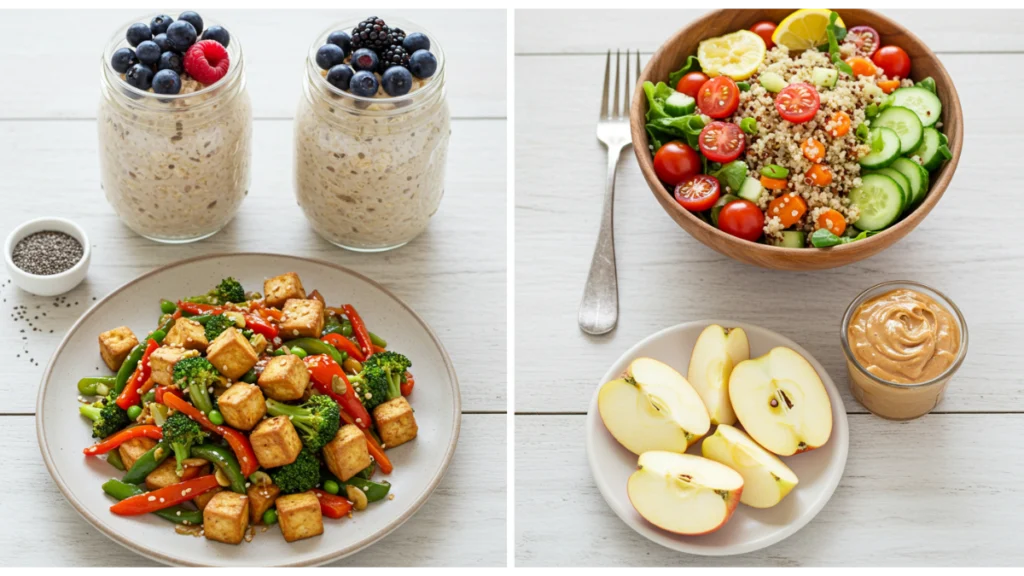
- Breakfast:Overnight Oats
- Ingredients: 1 cup rolled oats, 1 cup almond milk, 1 tablespoon chia seeds, 1 cup mixed berries, honey (optional).
- Instructions: In a jar, combine oats, almond milk, chia seeds, and honey. Stir well, cover, and refrigerate overnight. In the morning, top with mixed berries before serving.
- Lunch:Quinoa Salad
- Ingredients: 1 cup cooked quinoa, 1 cucumber (diced), 1 cup cherry tomatoes (halved), 1/4 cup red onion (finely chopped), 2 tablespoons olive oil, juice of 1 lemon, salt, and pepper.
- Instructions: In a large bowl, combine quinoa, cucumber, tomatoes, and red onion. Drizzle with olive oil and lemon juice, then season with salt and pepper before tossing to mix everything together.
- Dinner:Stir-Fried Tofu with Mixed Vegetables
- Ingredients: 1 block firm tofu (cubed), 2 cups mixed vegetables (bell peppers, broccoli, carrots), 2 tablespoons soy sauce, 1 tablespoon sesame oil, garlic, and ginger.
- Instructions: Heat sesame oil in a pan over medium heat. Add garlic and ginger, sauté for 1 minute. Add tofu and cook until golden brown. Stir in the vegetables along with the soy sauce, cooking until vegetables are tender.
- Snack:Apple with Almond Butter
- Cut an apple into slices and pair it with a tablespoon of almond butter for a delicious dip.
Day 2:

- Breakfast:Smoothie
- Ingredients: 1 banana, 1 cup spinach, 1 cup almond milk, 1 tablespoon peanut butter, ice cubes.
- Instructions: Blend all ingredients until smooth. Pour into a glass and enjoy.
- Lunch:Lentil Soup
- Ingredients: 1 cup lentils, 1 onion (chopped), 2 carrots (diced), 2 celery stalks (diced), 4 cups vegetable broth, spices (thyme, cumin, salt, and pepper).
- Instructions: In a pot, sauté onion, carrots, and celery until soft. Add lentils, broth, and spices. Simmer for 30 minutes until lentils are tender.
- Dinner:Vegetable Curry with Chickpeas
- Ingredients: 1 can chickpeas (drained), 1 can coconut milk, 2 cups mixed vegetables (cauliflower, peas, carrots), curry powder, garlic, and ginger.
- Instructions: In a pot, sauté garlic and ginger. Stir in the vegetables along with the curry powder, cooking for a few minutes before adding the chickpeas and coconut milk to simmer until warmed through.
- Snack:Carrot Sticks with Hummus
- Serve fresh carrot sticks with hummus for a nutritious snack.
Day 3:
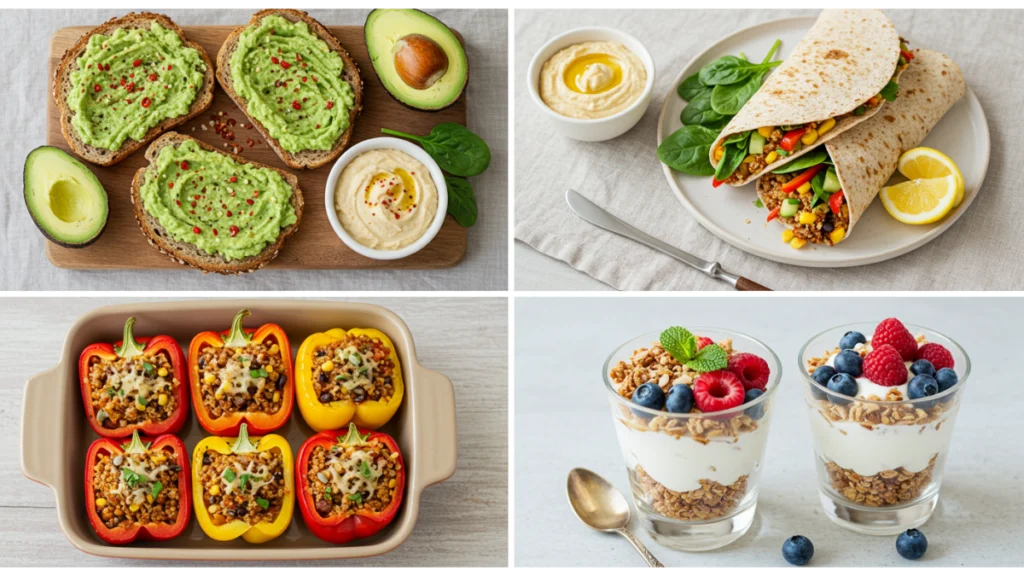
- Breakfast:Avocado Toast
- Ingredients: 2 slices whole grain bread, 1 ripe avocado, salt, pepper, and red pepper flakes.
- Instructions: Toast the bread. Mash the avocado and spread it on the toast. Season with salt, pepper, and red pepper flakes.
- Lunch:Hummus Wrap
- Ingredients: Whole wheat tortilla, 1/2 cup hummus, assorted vegetables (spinach, bell peppers, cucumbers).
- Instructions: Spread hummus on the tortilla, add vegetables, and roll it up tightly.
- Dinner:Stuffed Bell Peppers
- Ingredients: 4 bell peppers, 1 cup cooked quinoa, 1 can black beans (drained), 1 cup corn, spices (cumin, chili powder), cheese (optional).
- Instructions: Preheat the oven to 375°F (190°C). Remove the tops of the bell peppers and take out the seeds. In a bowl, mix quinoa, black beans, corn, and spices. Stuff the mixture into the peppers, top with cheese if desired, and bake for 30 minutes.
- Snack:Greek Yogurt with Honey
- In a glass or bowl, layer yogurt, granola, and berries for a delightful parfait.
Day 4:
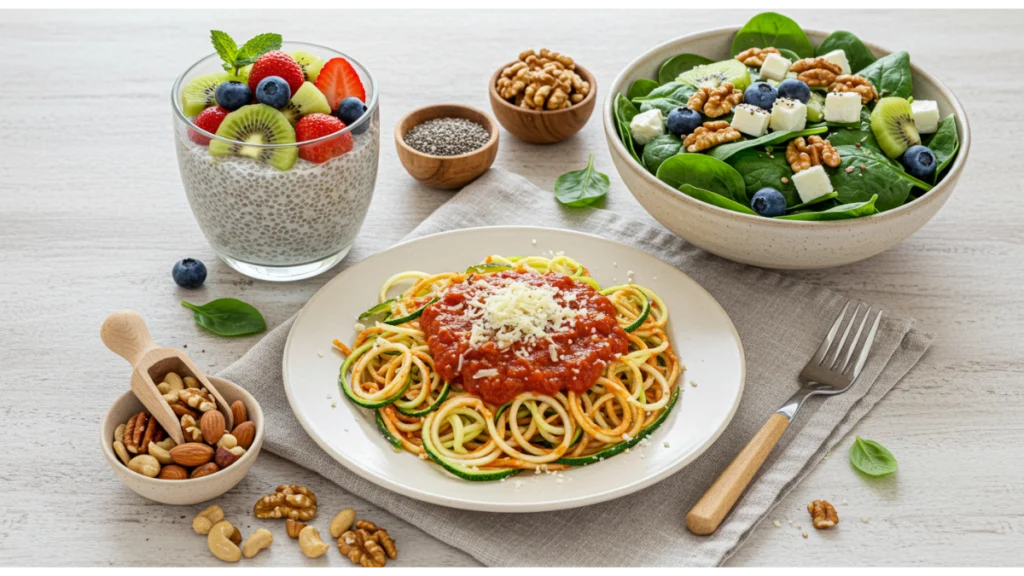
- Breakfast:Chia Pudding
- Ingredients: 1/4 cup chia seeds, 1 cup almond milk, 1 tablespoon maple syrup, fresh fruit for topping.
- Instructions: In a bowl, combine chia seeds, almond milk, and maple syrup, mixing thoroughly. Refrigerate for at least 4 hours or overnight. Top with fresh fruit before serving.
- Lunch:Spinach Salad
- Ingredients: 2 cups fresh spinach, 1/4 cup walnuts, 1/4 cup feta cheese, balsamic vinaigrette.
- Instructions: Toss spinach, walnuts, and feta cheese in a bowl. Drizzle with balsamic vinaigrette and serve.
- Dinner:Zucchini Noodles with Marinara Sauce
- Ingredients: 2 zucchinis (spiralized), 1 cup marinara sauce, 1/4 cup grated Parmesan cheese.
- Instructions: In a pan, heat marinara sauce. Add zucchini noodles and cook for 3-4 minutes until tender. Serve topped with Parmesan cheese.
- Snack:Mixed Nuts
- A handful of mixed nuts makes for a great protein-packed snack.
Day 5:
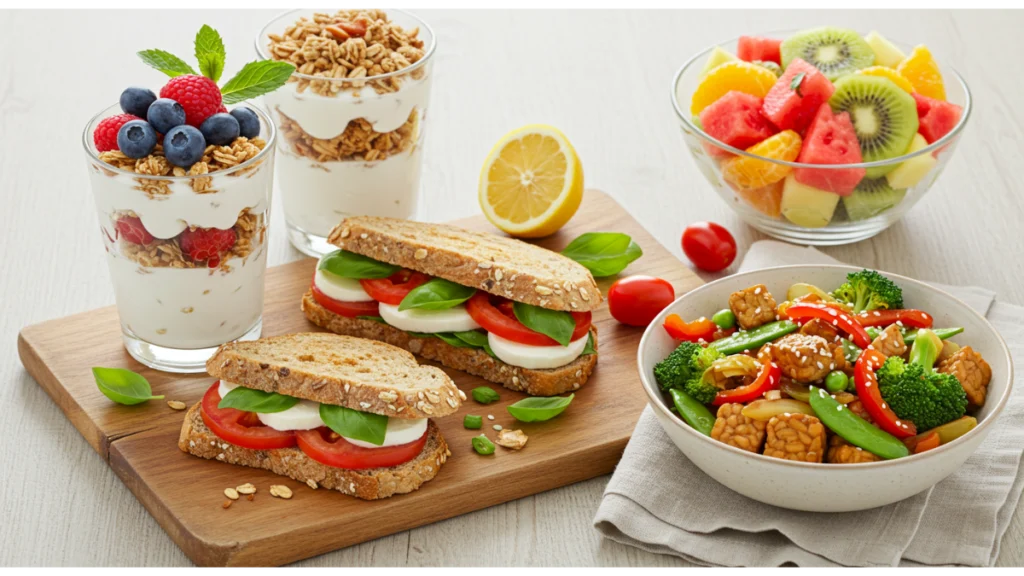
- Breakfast:Yogurt Parfait
- Ingredients: 1 cup Greek yogurt, 1/2 cup granola, 1/2 cup mixed berries.
- Instructions: Layer yogurt, granola, and berries in a glass or bowl. Serve immediately.
- Lunch:Caprese Sandwich
- Ingredients: Whole grain bread, fresh mozzarella, tomatoes, basil leaves, balsamic glaze.
- Instructions: Layer mozzarella, tomatoes, and basil on bread. Drizzle with balsamic glaze and serve.
- Dinner:Vegetable Stir-Fry with Tempeh
- Ingredients: 1 block tempeh (cubed), 2 cups mixed vegetables (broccoli, bell peppers, snap peas), soy sauce, garlic, and ginger.
- Instructions: Sauté garlic and ginger in a pan. Add tempeh and cook until golden. Stir in vegetables and soy sauce, cooking until vegetables are tender.
- Snack:Fruit Salad
- Combine seasonal fruits for a refreshing snack.
Day 6:
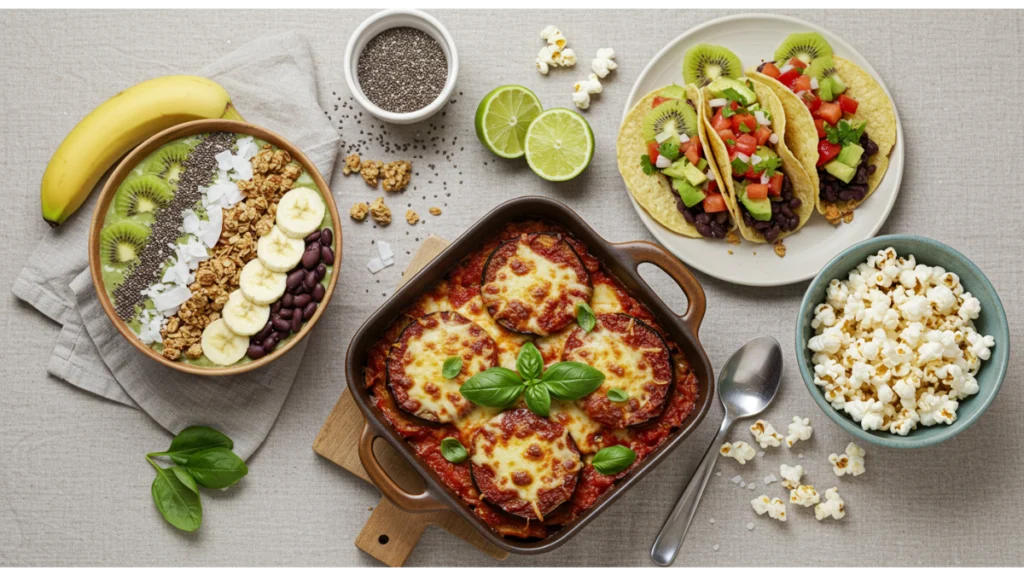
- Breakfast:Smoothie Bowl
- Ingredients: 1 banana, 1 cup spinach, 1/2 cup almond milk, toppings (granola, coconut flakes, sliced fruit).
- Instructions: Blend banana, spinach, and almond milk until smooth. Transfer to a bowl and garnish with granola, coconut flakes, and sliced fruit.
- Lunch:Black Bean Tacos
- Ingredients: Corn tortillas, 1 can black beans (drained), avocado, salsa, and cilantro.
- Instructions: Heat black beans in a pan. Serve in tortillas topped with avocado, salsa, and cilantro.
- Dinner:Eggplant Parmesan
- Ingredients: 1 eggplant (sliced), marinara sauce, mozzarella cheese, breadcrumbs, and Italian seasoning.
- Instructions: Preheat the oven to 375°F (190°C). Layer eggplant slices in a baking dish, alternating with marinara sauce and cheese. Top with breadcrumbs and bake for 30 minutes.
- Snack:Popcorn
- Air-popped popcorn seasoned with a sprinkle of salt makes for a light snack.
Day 7:
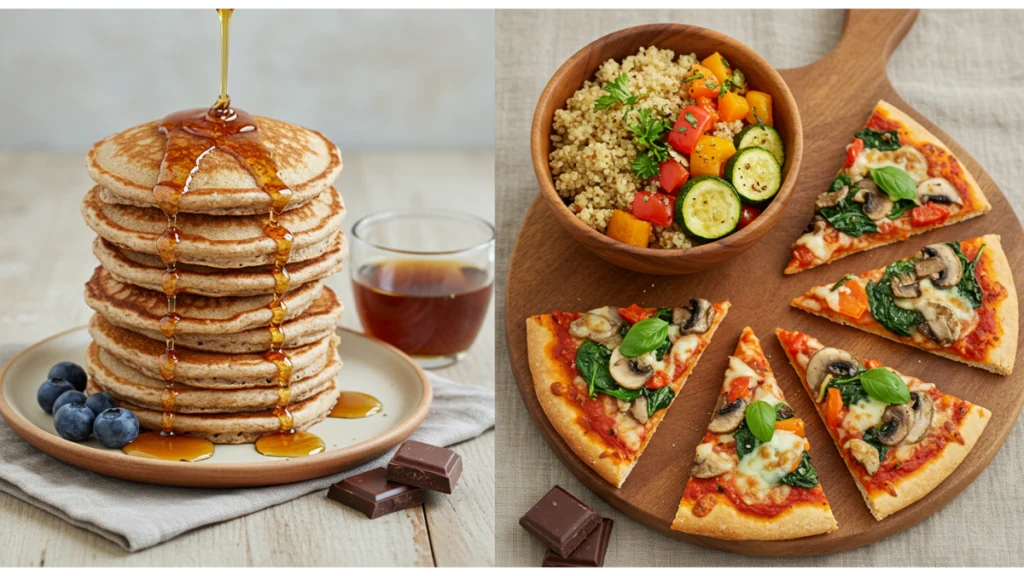
- Breakfast:Whole Wheat Pancakes
- Ingredients: 1 cup whole wheat flour, 1 tablespoon baking powder, 1 cup almond milk, maple syrup.
- Instructions: Mix flour and baking powder in a bowl. Add almond milk and stir until combined. Cook pancakes on a hot griddle until golden brown. Serve with maple syrup.
- Lunch:Quinoa and Roasted Vegetable Bowl
- Ingredients: 1 cup cooked quinoa, assorted roasted vegetables (zucchini, bell peppers, carrots), olive oil, salt, and pepper.
- Instructions: Toss vegetables with olive oil, salt, and pepper. Roast at 400°F (200°C) for 20-25 minutes. Serve over quinoa.
- Dinner:Veggie Pizza
- Ingredients: Whole wheat pizza crust, marinara sauce, assorted vegetables (mushrooms, spinach, bell peppers), mozzarella cheese.
- Instructions: Set the oven temperature according to the instructions for the pizza crust. Spread marinara sauce on the crust, top with vegetables and cheese, and bake until golden.
- Snack:Dark Chocolate
- A few squares of dark chocolate can satisfy your sweet tooth while providing antioxidants.
Nutritional Value
| Ingredient | Benefits |
|---|---|
| Quinoa | Complete protein source |
| Lentils | High in fiber and iron |
| Spinach | Rich in vitamins A and C |
| Chickpeas | Excellent source of protein |
| Eggs (if included) | High in protein and nutrients |
| Nuts | Healthy fats and protein |
| Greek Yogurt | Probiotics and calcium |
Benefits of a 7-Day Vegetarian Meal Plan
Following a vegetarian meal plan can offer a variety of health advantages. For instance, the increased intake of fruits and vegetables can boost your immune system and improve your digestion. Additionally, plant-based diets are often lower in calories and saturated fats, making them a great choice for weight management.
- Improved Energy Levels:
- Many individuals report feeling more energetic after switching to a vegetarian diet. The abundance of vitamins, minerals, and antioxidants found in plant-based foods can enhance overall vitality.
- Enhanced Mood and Mental Clarity:
- A diet abundant in fruits and vegetables has been associated with enhanced mood and better cognitive function. Nutrient-dense foods can positively impact brain health and emotional well-being.
- Reduced Risk of Chronic Diseases:
- Research indicates that vegetarian diets are associated with a lower risk of heart disease, hypertension, type 2 diabetes, and certain cancers. The emphasis on whole foods and plant-based nutrition contributes to a healthier lifestyle.
- Increased Variety in Diet:
- A vegetarian meal plan encourages you to explore a wide range of foods, making your meals more interesting and diverse. This variety can help prevent boredom and promote a more sustainable dietary change.
Overcoming Challenges
Transitioning to a vegetarian diet may present challenges such as meal planning and ensuring adequate protein intake. Here are some common challenges and practical solutions:
- Meal Planning:
- Challenge: It can be difficult to know what to prepare each day.
- Solution: Utilize this 7-day meal plan as a guide. Consider batch cooking and prepping ingredients in advance to simplify your week.
- Protein Intake:
- Challenge: Many people worry about getting enough protein on a vegetarian diet.
- Solution: Include a variety of legumes, tofu, tempeh, nuts, and seeds in your meals for balanced nutrition.
- Social Situations:
- Challenge: Eating out or attending social gatherings can be tricky.
- Solution: Research restaurant menus ahead of time and don’t hesitate to ask for vegetarian options. Bring a dish to share at gatherings to ensure you have something you can enjoy.
- Nutritional Balance:
- Challenge: Ensuring you’re getting all essential nutrients can be a concern.
- Solution: Focus on a balanced diet that includes a variety of foods. If needed, consult with a nutritionist to identify any potential gaps in your diet.
Future Trends in Vegetarian Eating
The vegetarian food landscape is evolving, with an increasing focus on sustainability and innovative plant-based products. Here are some trends to watch:
- Plant-Based Alternatives:
- The market for plant-based meat and dairy alternatives continues to grow, providing more options for those transitioning to a vegetarian lifestyle. These products are becoming more accessible in grocery stores and restaurants.
- Sustainable Practices:
- An increasing number of consumers are becoming aware of how their food choices affect the environment. There is a growing emphasis on sustainable farming practices and sourcing local ingredients.
- Health and Wellness:
- As more research highlights the health benefits of plant-based diets, individuals are increasingly adopting vegetarianism for health reasons. This trend is likely to continue as awareness of chronic diseases rises.
- Culinary Innovation:
- Chefs and home cooks alike are experimenting with new ingredients and cooking techniques, leading to exciting and flavorful vegetarian dishes. Expect to see more creative uses of vegetables, grains, and legumes in the culinary world.
Tips and Tricks Section
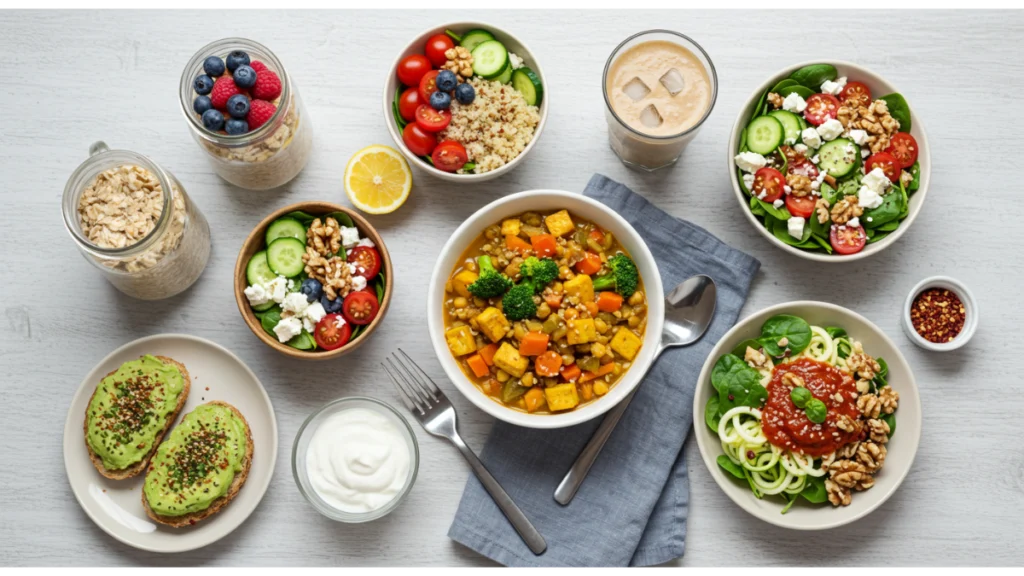
To make the most of your vegetarian meal plan, consider these helpful tips:
- Meal Prep:
- Spend a few hours on the weekend prepping your meals for the week to save time. Chop vegetables, cook grains, and prepare sauces in advance to streamline your cooking process.
- Flavor Enhancements:
- Experiment with herbs and spices to elevate the taste of your dishes. Fresh herbs like basil, cilantro, and parsley can add a burst of flavor, while spices like cumin, paprika, and turmeric can enhance the overall profile of your meals.
- Storage:
- Store your meals in airtight containers to maintain freshness throughout the week. Invest in good-quality storage solutions to make meal prep easier and more efficient.
- Stay Hydrated:
- Don’t forget to drink plenty of water throughout the day. Staying hydrated is essential for overall health and can help you feel more energized.
- Listen to Your Body:
- Pay attention to your hunger cues and adjust portion sizes accordingly. If you’re feeling particularly hungry, don’t hesitate to increase your portions or add a healthy snack. Conversely, if you’re not very hungry, it’s perfectly fine to eat smaller portions.
- Explore New Ingredients:
- Incorporate a variety of legumes, tofu, tempeh, nuts, and seeds into your meals for balanced nutrition. Trying new ingredients can keep your meals exciting and expose you to different flavors and textures.
- Plan for Snacks:
- Healthy snacks can help bridge the gap between meals and prevent overeating later. Keep a stash of nutritious snacks like fruit, nuts, or yogurt on hand to make healthy choices easy.
- Incorporate Seasonal Produce:
- Using seasonal fruits and vegetables not only enhances the flavor of your meals but also supports local farmers and reduces your carbon footprint. Check your local farmers’ market for fresh, in-season produce.
- Get Creative with Leftovers:
- Don’t let leftovers go to waste! Use them creatively in new dishes. For example, leftover roasted vegetables can be added to wraps, salads, or grain bowls, while extra grains can be turned into soups or stir-fries.
Variations and Adaptations
To accommodate different dietary preferences and needs, consider these variations and adaptations of the meal plan:
- Gluten-Free Options:
- Substitute whole grain bread with gluten-free bread or wraps. Use quinoa or rice instead of wheat-based grains.
- Dairy-Free Options:
- Replace dairy products with plant-based alternatives. Use almond milk, coconut yogurt, and nutritional yeast for a cheesy flavor without dairy.
- High-Protein Variations:
- For those looking to boost protein intake, incorporate more legumes, tempeh, or seitan into meals. Consider adding protein powder to smoothies or oatmeal for an extra protein punch.
- Low-Carb Alternatives:
- If you’re following a low-carb diet, focus on non-starchy vegetables and reduce grain portions. Zucchini noodles or cauliflower rice can serve as excellent substitutes for traditional pasta and rice.
- Kid-Friendly Adjustments:
- Make meals more appealing to children by involving them in the cooking process. Create fun shapes with fruits and vegetables, or let them assemble their own wraps and sandwiches.
FAQs Section
To further assist you in your vegetarian journey, here are some frequently asked questions and their answers:
u003cstrongu003eHow can I store leftovers?u003c/strongu003e
Store your meals in airtight containers to maintain freshness throughout the week. Most cooked dishes can be safely stored for 3-4 days. For longer storage, consider freezing portions and labeling containers with the date to keep track of freshness.
u003cstrongu003eCan I adjust portion sizes?u003c/strongu003e
Absolutely! Listen to your body’s hunger signals and modify portion sizes as needed. If you’re more active, you might require larger portions or additional snacks.
u003cstrongu003eWhat are some easy vegetarian recipes for beginners?u003c/strongu003e
u003cstrongu003eare some easy vegetarian recipes for beginners?u003c/strongu003eu003cbru003eStart with simple recipes like vegetable stir-fries, pasta with marinara sauce, or grain bowls. These dishes are easy to prepare and can be customized with your favorite ingredients.
u003cstrongu003eHow can I ensure I’m getting enough protein?u003c/strongu003e
Incorporate legumes, tofu, tempeh, nuts, and seeds into your meals. These foods are excellent sources of plant-based protein that can help meet your nutritional needs.
u003cstrongu003eWhat if I don’t like certain vegetables?u003c/strongu003e
It’s important to find vegetables you enjoy. Experiment with different cooking methods, such as roasting, steaming, or grilling, to enhance their flavors. You can also try incorporating vegetables into smoothies or sauces where their taste is less pronounced.
Conclusion
This 7-day vegetarian meal plan is a fantastic way to embrace a healthier lifestyle while enjoying delicious meals. The recipes are designed to be simple yet flavorful, making it easy for anyone to incorporate more plant-based foods into their diet. Remember, the key is to experiment with flavors and ingredients that excite you.
As you embark on this journey, keep an open mind, and don’t hesitate to modify the recipes to suit your taste preferences. Share your experiences and variations in the comments below, and don’t forget to subscribe for more meal planning tips! Your health is a lifelong journey, and with this meal plan, you’re taking a significant step toward nourishing your body and mind.
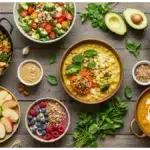
7-Day Vegetarian Meal Plan
Ingredients
Fruits
- 1 cup Bananas Fresh, ripe
- 1 cup Berries Various types, fresh or frozen
- 1 cup Apples Fresh, sliced
- 1 cup Oranges Fresh, segmented
- as needed Seasonal fruits
Vegetables
- 2 cups Spinach Fresh
- 1 cup Kale Fresh, torn
- 4 pieces Bell peppers
- 2 pieces Carrots Diced
- 1 head Broccoli Cut into florets
- 2 pieces Zucchini Sliced
- 1 piece Onion Chopped
Whole Grains
- 1 cup Quinoa Cooked
- 1 cup Brown rice Cooked
- 1 slice Whole wheat bread
- 1 cup Oats
- 1 cup Barley Cooked
Legumes
- 1 cup Lentils Cooked
- 1 can Chickpeas Drained
- 1 can Black beans Drained
- 1 can Kidney beans Drained
Nuts and Seeds
- 1/2 cup Almonds Chopped
- 1/2 cup Walnuts Chopped
- 2 tablespoons Chia seeds
- 2 tablespoons Flaxseeds Ground
- 1/4 cup Pumpkin seeds Raw
Dairy or Dairy Alternatives
- 1 cup Greek yogurt or plant-based alternative
- 1 cup Almond milk or other plant-based milk
- 1 cup Soy milk or coconut yogurt
Optional Protein
- 2 pieces Eggs Optional for lacto-vegetarians
Instructions
Preparation
- Gather all necessary ingredients based on the daily meal plans provided.
Cooking – Day by Day
- Follow the meal plan for each day, preparing breakfast, lunch, dinner, and snacks as outlined.

